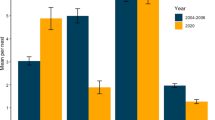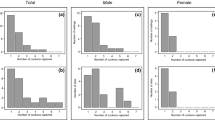Abstract
Knowledge of the quantitative genetics of resistance to parasitism is key to appraise host evolutionary responses to parasite selection. Here, we studied effects of common origin (i.e. genetic and pre-hatching parental effects) and common rearing environment (i.e. post-hatching parental effects and other environment effects) on variance in ectoparasite load in nestling Alpine swifts (Apus melba). This colonial bird is intensely parasitized by blood sucking louse-flies that impair nestling development and survival. By cross-fostering half of the hatchlings between pairs of nests, we show strong significant effect of common rearing environment on variance (90.7% in 2002 and 90.9% in 2003) in the number of louse-flies per nestling and no significant effect of common origin on variance in the number of louse-flies per nestling. In contrast, significant effects of common origin were found for all the nestling morphological traits (i.e. body mass, wing length, tail length, fork length and sternum length) under investigation. Hence, our study suggests that genetic and pre-hatching parental effects play little role in the distribution of parasites among nestling Alpine swifts, and thus that nestlings have only limited scope for evolutionary responses against parasites. Our results highlight the need to take into consideration environmental factors, including the evolution of post-hatching parental effects such as nest sanitation, in our understanding of host-parasite relationships.

Similar content being viewed by others
References
Ardia, D. R., & Rice, E. B. (2006). Variation in heritability of immune function in the tree swallow. Evolutionary Ecology, 20, 491–500.
Arn, H. (1960). Biologische Studien am Alpensegler. Solothurn, Switzerland: Verlag Vogt-Schild AG.
Badyaev, A. V., Hamstra, T. L., Oh, K. P., & Acevedo Seaman, D. A. (2006). Sex-biased maternal effects reduce ectoparasite-induced mortality in a passerine bird. Proceeding of the National Academy of Sciences of the United States of America, 103, 14406–14411.
Bize, P., Jeanneret, C., Klopfenstein, A., & Roulin, A. (2008). What makes a host profitable? Experimental evidence that parasites balance host nutritive resources against immunity. American Naturalist, 171, 107–118. doi:10.1086/523943.
Bize, P., Metcalfe, N. B., & Roulin, A. (2006). Catch up growth strategies differ between body structures: Interactions between age and structure-specific growth in wild nestling Alpine swifts. Functional Ecology, 20, 857–864. doi:10.1111/j.1365-2435.2006.01157.x.
Bize, P., Roulin, A., Bersier, L.-F., Pfluger, D., & Richner, H. (2003). Parasitism and developmental plasticity in Alpine swift nestlings. Journal of Animal Ecology, 72, 633–639. doi:10.1046/j.1365-2656.2003.00734.x.
Bize, P., Roulin, A., & Richner, H. (2004a). Parasitism, developmental plasticity and bilateral asymmetry of wing feathers in Alpine swift (Apus melba) nestlings. Oikos, 106, 317–323. doi:10.1111/j.0030-1299.2004.13019.x.
Bize, P., Roulin, A., Tella, J. L., Bersier, L.-F., & Richner, H. (2004b). Additive effects of ectoparasites over the reproductive attempts in the long-lived Alpine swifts. Journal of Animal Ecology, 73, 1080–1088. doi:10.1111/j.0021-8790.2004.00880.x.
Bize, P., Roulin, A., Tella, J. L., & Richner, H. (2005). Female-biased mortality in experimentally parasitized Alpine swift Apus melba nestlings. Functional Ecology, 19, 405–413. doi:10.1111/j.1365-2435.2005.00995.x.
Blanford, S., Thomas, M. B., Pugh, C., & Pell, J. K. (2003). Temperature checks the Red Queen? Resistance and virulence in a fluctuating environment. Ecology Letters, 6, 2–5. doi:10.1046/j.1461-0248.2003.00387.x.
Boulinier, T., & Staszewski, V. (2008). Maternal transfer of antibodies: Raising immuno-ecology issues. Trends in Ecology & Evolution, 23, 282–288. doi:10.1016/j.tree.2007.12.006.
Charmantier, A., & Garant, D. (2005). Environmental quality and evolutionary potential: Lessons from wild populations. Proceedings of the Royal Society of London. Series B: Biological Sciences, 272, 1415–1425. doi:10.1098/rspb.2005.3117.
Christe, P., Møller, A. P., & de Lope, F. (1998). Immunocompetence and nestling survival in the house martin: The tasty chick hypothesis. Oikos, 83, 175–179. doi:10.2307/3546559.
Christe, P., Møller, A. P., Saino, N., & de Lope, F. (2000). Genetic and environmental components of phenotypic variation in immune response and body size of a colonial bird, Delichon urbica (the house martin). Heredity, 85, 75–83. doi:10.1046/j.1365-2540.2000.00732.x.
Christe, P., Oppliger, A., Bancalà, F., Castella, G., & Chapuisat, M. (2003). Evidence for collective medication in ants. Ecology Letters, 6, 19–22. doi:10.1046/j.1461-0248.2003.00395.x.
Christe, P., Richner, H., & Oppliger, A. (1996). Of great tits and fleas: Sleep baby sleep. Animal Behaviour, 52, 1087–1092. doi:10.1006/anbe.1996.0256.
Clayton, D. H., Lee, P. L. M., Tompkins, D. M., Brodie, E. D., III. (1999). Reciprocal natural selection on host-parasite phenotypes. American Naturalist, 154, 261–270. doi:10.1086/303237.
Clayton, D. H., & Moore, H. (Eds.). (1997). Host-parasite evolution general principles and Avian models. Oxford: Oxford University Press.
Clayton, D. H., Moyer, B. R., Bush, S. E., Jones, T. G., Gardiner, D. W., Rhodes, B. B., et al. (2005). Adaptive significance of avian beak morphology for ectoparasite control. Proceedings of the Royal Society of London. Series B: Biological Sciences, 272, 811–817. doi:10.1098/rspb.2004.3036.
Combes, C. (2001). Parasitism: The ecology and evolution of intimate interactions. Chicago: University of Chicago Press.
de Roode, J. C., Pedersen, A. B., Hunter, M. D., & Altizer, S. (2008). Host plant species affects virulence in monarch butterfly parasites. Journal of Animal Ecology, 77, 120–126. doi:10.1111/j.1365-2656.2007.01305.x.
Dybdahl, M. F., & Krist, A. C. (2004). Genotypic vs condition effects on parasite-driven rare advantage. Journal of Evolutionary Biology, 17, 967–973. doi:10.1111/j.1420-9101.2004.00759.x.
Falconer, D. S., & Mackay, T. F. C. (1996). Introduction to quantitative genetics. London: Longman.
Ferguson, H. M., & Read, A. F. (2002). Genetic and environmental determinants of malaria parasite virulence in mosquitoes. Proceedings of the Royal Society of London. Series B: Biological Sciences, 269, 1217–1224. doi:10.1098/rspb.2002.2023.
Gasparini, J., Piault, R., Bize, P., & Roulin, A. Pre-hatching maternal effects inhibit nestling humoral immune response in the tawny owl. Journal of Avian Biology (in press).
Greischar, M. A., & Koskella, B. (2007). A synthesis of experimental work on parasite local adaptation. Ecology Letters, 10, 418–434. doi:10.1111/j.1461-0248.2007.01028.x.
Hagemeijer, E. J. M., & Blair, M. J. (Eds.). (1997). The EBCC atlas of European breeding birds: Their distribution and abundance. London: T & A D Poyser.
Hamilton, W. D. (1980). Sex versus non-sex versus parasites. Oikos, 35, 282–290. doi:10.2307/3544435.
Heeb, P., Kölliker, M., & Richner, H. (2000). Bird-ectoparasite interactions nest humidity and ectoparasite community structure. Ecology, 81, 958–968.
Jaenike, J. (1978). An hypothesis to account for the maintenance of sex within population. Evolutionary Theory, 3, 191–194.
Krasnov, B. R., Khokhlova, I. S., Arakelyan, M. S., & Degen, A. A. (2005). Is a starving host tastier? Reproduction in fleas parasitizing food-limited rodents. Functional Ecology, 19, 625–631. doi:10.1111/j.1365-2435.2005.01015.x.
Laine, A. L. (2008). Temperature-mediated patterns of local adaptation in a natural plant-pathogen metapopulation. Ecology Letters, 11, 327–337. doi:10.1111/j.1461-0248.2007.01146.x.
Lambrechts, L., Chavatte, J. M., Snounou, G., & Koella, J. C. (2006). Environmental influence on the genetic basis of mosquito resistance to malaria parasites. Proceedings of the Royal Society of London. Series B: Biological Sciences, 273, 1501–1506. doi:10.1098/rspb.2006.3483.
Little, T. J., & Ebert, D. (2000). The cause of parasitic infection in natural populations of Daphnia (Crustacea: Cladocera): The role of host genetics. Proceedings of the Royal Society of London. Series B: Biological Sciences, 267, 2037–2042. doi:10.1098/rspb.2000.1246.
Lively, C. M. (1999). Migration virulence and the geographic mosaic of adaptation by parasites. American Naturalist, 153, S34–S47. doi:10.1086/303210.
Lively, C. M., & Dybdahl, M. F. (2000). Parasite adaptation to locally common host genotypes. Nature, 405, 679–681. doi:10.1038/35015069.
McCoy, K. D., Boulinier, T., Schjørring, S., & Michalakis, Y. (2002). Local adaptation of an ectoparasite Ixodes uriae to its seabird host. Evolutionary Ecology Research, 4, 441–456.
Merilä, J. (1996). Genetic variation in offspring condition: An experiment. Functional Ecology, 10, 465–474. doi:10.2307/2389939.
Møller, A. P. (1990). Effects of a haematophagous mite on the barn swallow (Hirundo rustica): A test of the Hamilton and Zuck hypothesis. Evolution; International Journal of Organic Evolution, 44, 771–784. doi:10.2307/2409545.
Møller, A. P., Martinelli, R., & Saino, N. (2004). Genetic variation in infestation with a directly transmitted ectoparasite. Journal of Evolutionary Biology, 17, 41–47. doi:10.1046/j.1420-9101.2003.00660.x.
Mousseau, T. A., & Fox, C. W. (1998). The adaptive significance of maternal effects. Trends in Ecology & Evolution, 13, 403–407. doi:10.1016/S0169-5347(98)01472-4.
Mousseau, T. A., & Roff, D. A. (1986). Natural selection and the heritability of fitness components. Heredity, 59, 181–197. doi:10.1038/hdy.1987.113.
Müller, W., Groothuis, T. G., Kasprzik, A., Dijkstra, C., Alatalo, R. V., & Siitari, H. (2005). Prenatal androgen exposure modulates cellular and humoral immune function of black-headed gull chicks. Proceedings of the Royal Society of London. Series B: Biological Sciences, 272, 1971–1977. doi:10.1098/rspb.2005.3178.
Petit, C., Hossaert-McKey, M., Perret, P., Blondel, J., & Lambrechts, M. M. (2002). Blue tits use selected plants and olfaction to maintain an aromatic environment for nestlings. Ecology Letters, 5, 585–589. doi:10.1046/j.1461-0248.2002.00361.x.
Roff, D. A. (1997). Evolutionary quantitative genetics. New York: Chapman Hall.
Roulin, A., Brinkhof, M. W. G., Bize, P., Richner, H., Jungi, T. W., Bavoux, C., et al. (2003). Which chick is tasty to parasites? The importance of host immunology versus parasite life history. Journal of Animal Ecology, 72, 75–81. doi:10.1046/j.1365-2656.2003.00677.x.
Roulin, A., Christe, P., Dijkstra, C., Durcrest, A. L., & Jungi, T. W. (2007). Origin-related environmental sex and age determinants of immunocompetence susceptibility to ectoparasites and disease symptoms in the barn owl. Biological Journal of the Linnaean Society, 90, 703–718. doi:10.1111/j.1095-8312.2007.00759.x.
Roulin, A., Gasparini, J., & Froissart, L. (2008). Pre-hatching maternal effects and the tasty chick hypothesis. Evolutionary Ecology Research, 10, 463–473.
Shaw, D. J., Grenfell, B. T., & Dobson, A. P. (1998). Patterns of macroparasite aggregation in wildlife host populations. Parasitology, 117, 597–610. doi:10.1017/S0031182098003448.
Sorci, G., Møller, A. P., & Boulinier, T. (1997). Genetics of host–parasite interactions. Trends in Ecology & Evolution, 12, 196–200. doi:10.1016/S0169-5347(97)01056-2.
Tinsley, M. C., Blanford, S., & Jiggins, F. M. (2006). Genetic variation in Drosophila melanogaster pathogen susceptibility. Parasitology, 132, 767–773. doi:10.1017/S0031182006009929.
Tschirren, B., Fitze, P. S., & Richner, H. (2003). Sexual dimorphism in susceptibility to parasites and cell-mediated immunity in great tit nestlings. Journal of Animal Ecology, 72, 839–845. doi:10.1046/j.1365-2656.2003.00755.x.
Wiehn, J., & Korpimäki, E. (1998). Resource levels reproduction and resistance to haematozoan infections. Proceedings of the Royal Society of London. Series B: Biological Sciences, 265, 1197–1201. doi:10.1098/rspb.1998.0419.
Wolf, J. B., Broodie, E. D., I. I. I., Cheverud, J. M., Moore, A. J., & Wade, M. J. (1998). Evolutionary consequences of indirect genetic effects. Trends in Ecology & Evolution, 13, 64–69. doi:10.1016/S0169-5347(97)01233-0.
Acknowledgements
We thank Dominik Pfluger and the late Theo Marbot for allowing us to access the colonies, the Swiss National Science Foundation for support (grants n° PP00A-109009 to PB and n° PP00A-102913 to AR), and two anonymous referees for helpful comments. Cross-fostering experiments were carried out under the authorization of the Veterinary Offices of the Cantons Bern and Solothurn.
Author information
Authors and Affiliations
Corresponding author
Rights and permissions
About this article
Cite this article
Bize, P., Roulin, A. Effects of Common Origin and Common Rearing Environment on Variance in Ectoparasite Load and Phenotype of Nestling Alpine Swifts. Evol Biol 36, 301–310 (2009). https://doi.org/10.1007/s11692-009-9063-x
Received:
Accepted:
Published:
Issue Date:
DOI: https://doi.org/10.1007/s11692-009-9063-x




